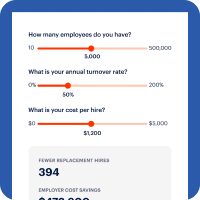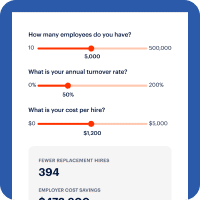Payroll schedules need to toe the line between meeting employees’ expectations and doing what’s right for your company’s bottom line.
The more frequently you run payroll at your organization, the more potential strain you may place on your payroll team. Higher frequency payroll can be more expensive to maintain, but reduced payroll frequency may interfere with employees’ expectations.
So, what’s the right balance? How do weekly and biweekly pay schedules compare from an employer and employee perspective?
An on-demand pay benefit may be the best of both worlds for employers and employees because employers can run payroll biweekly or even less frequently while their employees can access their earned pay more frequently if they need it.
What Are the Pros and Cons of a Weekly Pay Schedule?
Pros
Builds trust with employees and improves morale: Are you looking for a way to improve employee morale? Paying them more often might be an incentive to improve attendance rates and increase productivity.
Flows better with hourly pay structure: Hourly employees may have inconsistent weekly work schedules that can include overtime. Weekly pay matches this inconsistent flow of work. If an employee works overtime one week and less than full-time the next, then weekly payroll ensures that the company pays the employee’s overtime faster.
It’s easy to get into a payroll flow: With weekly payroll, you can be more organized. There is no confusion about when time cards need to be in or when payroll needs to be completed. You simply choose a particular day of the week and stick to it week in and week out. This goes a long way to ensure that the task is completed, without deviation.
Cons
Expensive for businesses: Weekly checks are not financially smart for small businesses. According to NFIB, individual deposit fees range from about $1.50 to $1.90 per deposit, on average.1 If you are a mid- to large-sized business, these fees add up quickly.
Time-consuming for businesses: Payroll administration needs to account for more than just the weekly payments provided to employees. It also includes the following:
- Wage garnishments
- Pay raises and pay cuts
- Sick pay
- Paid time off
- Taxes
- Other compensation-related issues
It’s time-consuming to track all of these items down. The more often you pay your employees, the less time you have for necessary administrative duties.
Aren’t sure what an on-demand pay benefit is? Need to find out more?
The Pros and Cons of a Biweekly Pay Schedule
Pros
Saves time: Paying employees biweekly instead of weekly requires an employer to process payroll only once every two weeks which reduces time spent on payroll processing and the likelihood of payroll errors, which can be equally time-consuming.
Simplifies Reconciliation: A weekly payroll means employees might not get around to cashing paper checks in a timely manner. Tracking live outstanding checks can be a burden for payroll. A more frequent payroll can also make it more difficult to account for taxes so distributing taxes over a longer period lowers the possibility of paying the IRS for mistakes.
Saves money: If you use a payroll vendor, it’s likely they charge for each payroll run. If you have dozens of employees on weekly schedules, these fees can add up. Depending on the number of employees that still receive paper checks, payroll costs could also be significantly lower with biweekly pay.
Con
Your employees are paid less frequently: Payroll is closely associated with the morale of the workplace. The more often employees see the fruits of their labor, the higher morale may be. Paying employees more often may also help alleviate financial burdens for employees.
So, What is the Happy Medium?
As you can see, there is a great divide. Biweekly is more convenient for employers because of the costs and time associated with running payroll. For some companies who still issue paper checks it can mean a significant increase in payroll cost for printing and mailing. And, weekly pay tends to be more beneficial for employees who want their money as soon as they earn it.
But what if a company could offer biweekly pay, and still allow their employees to access their earned pay more frequently if they need it? Consider offering an on-demand pay option, such as the one DailyPay offers, that allows your employees to access their earned pay more frequently, without having to change your payroll processes and without adding additional administrative burden to your payroll team!
Want to learn more about how offering an on-demand pay benefit can help your company and your employees?
FAQs
-
Is Pay Frequency regulated by the government?
Yes. Nearly every state has requirements for pay frequency. Alabama and Florida are the only states that do not have specific requirements.1
-
Are there states where weekly pay to employees is mandatory?
Yes, some states pay on a weekly basis, although there are exceptions based on salaries. These states and territories include California, Connecticut, Iowa, Massachusetts, Michigan, New Hampshire, New York, Puerto Rico, Rhode Island, Vermont and Virginia2
-
Can workers be paid more frequently than weekly?
Weekly payday is the shortest frequency. Employees looking to access their earned wages more frequently can use EWA (also known as on-demand pay).
-
Can salaried workers request being paid weekly instead of bi-weekly?
Employers typically set pay schedules based on the regulation for their state. Employees looking to access their earned wages more frequently can use EWA (also known as on-demand pay).
-
Is it better to get paid weekly or biweekly for taxes?
Your taxes will be the same, regardless of your pay frequency.
-
Can employees choose their pay frequency?
Employers typically set pay schedules based on the regulation for their state. Employees looking to access their earned wages more frequently can use EWA (also known as on-demand pay).
All information herein is for educational purposes only and should not be relied upon for any other use. The information herein does not constitute the rendering of professional advice by DailyPay. DailyPay does not warrant the completeness or accuracy of any information provided to you.













